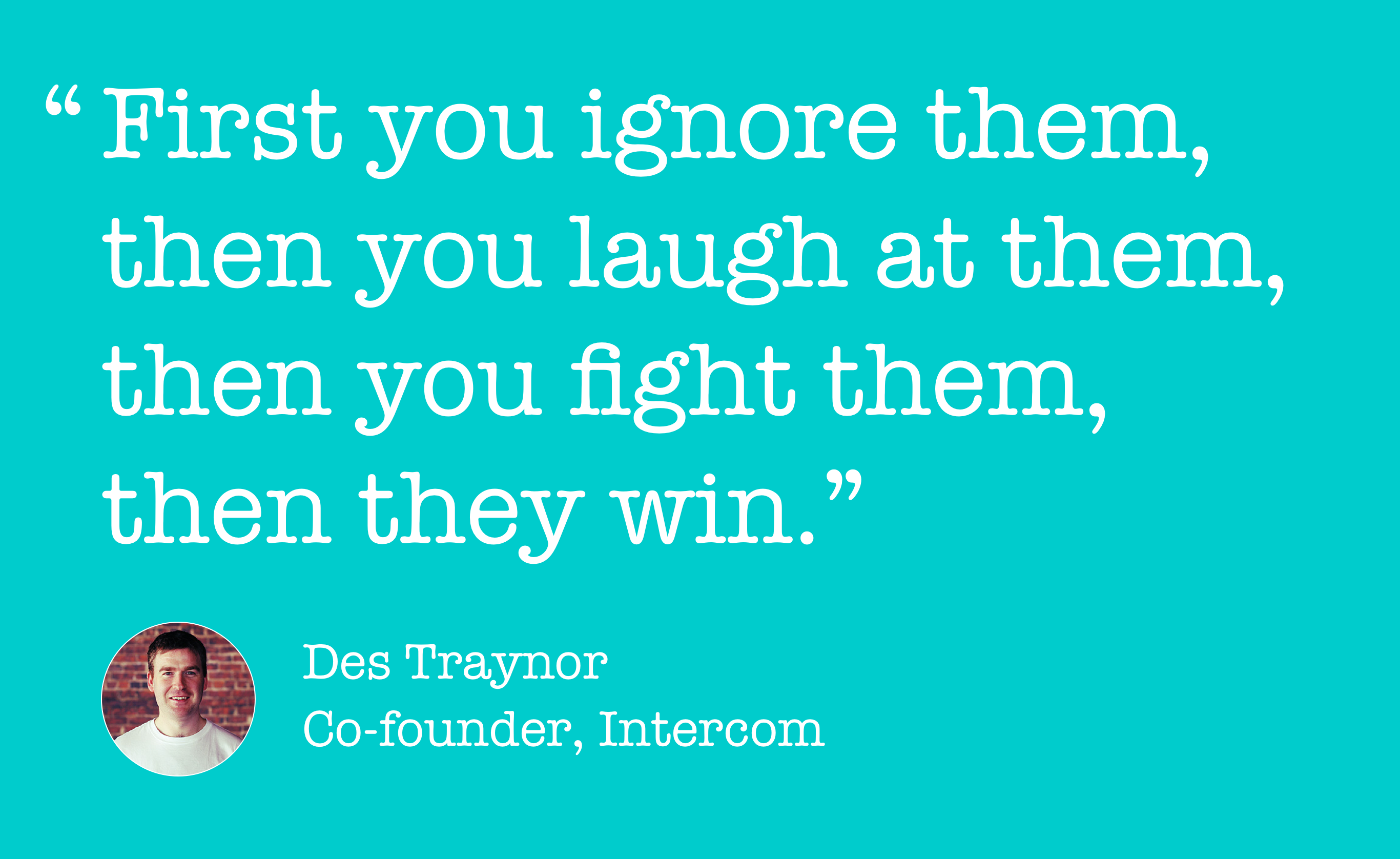Intercom has 10K+ customers, $10s of millions in revenue, and $116M raised. How can your company get there, too?
It has to stay alive.
“Make it work, make it grow, keep it relevant.”
That was the topic of Des Traynor’s keynote talk in Berlin, his only European visit on Inside Intercom’s World Tour. From the stage of the beautiful Delphi Theater, Des — co-founder, Chief Strategy Officer and VP Marketing at Intercom — laid out survival guidelines for any product in today’s evolving tech scene. His motivation is simple.
“We didn’t come this far, to only come this far.”
No matter how far your company has come, your product will always face threats of disruption, of being made obsolete. And it’s imperative that founders, execs, anyone who cares about the product, to stay honest about this fact. Des admitted it to the crowd.
“It’s when you’re at your most successful point that you feel most vulnerable.”
Ironic, right? But you know what happens when you rest on your laurels… You get taken down.
As such, nearly all key points of keeping a product alive came down to the character of the team behind the product itself. It’s essential for any product team, at any scale of company, to embody these three things:
- Self and industry awareness
- Forward thinking
- Decisive action
Self and industry awareness
“There’s no email from YC telling you it’s over.”
Shifts in tech are subtle, he says. If you’re not staying attuned to every move in the industry and shift of your customer’s needs, then your product is already obsolete.
You must pay close attention to the new technologies creeping up behind you, even if you are wildly outperforming them at the moment. Because those are the ones who will disrupt you. Without that awareness and attention — taking innovators and upcomers seriously — you’ll be swiftly overtaken. Des inverted a famous Gandhi quote to articulate his point:

Des pointed to SMS to Garmin, which was an industry leader up until 2007, and which now sustains itself merely by selling data to the companies that defeated them. And another great example: SMS vs. WhatsApp.
The API trend is a perfect example of how subtle shifts can compound to topple industries. Now so many APIs exist that brand new companies can use them as building blocks to tower over everyone else.
Des explained how someone could integrate Stripe, Shopify, and Postmates, and voila — “incorporate and run a same day delivery online store in 30 minutes.” Alex MacCaw, CEO of Clearbit, recently made the same point about Uber, which was initially build on four APIs. If the right APIs are “in place and you can build on top of them, that’s when you can build the world’s biggest company,” Alex says.
Forward thinking
“The present is the past.”
Don’t base your product decisions on how your customers act today; base the decisions on how your customers will act tomorrow. If you’re thinking about today, then your product is already obsolete.
Founders and product teams must constantly ask themselves: “Does [this technology] make it cheaper, faster, or easier for our customers to make progress in their lives?”
Decisive action
“Customers don’t wait around while you’re writing your JIRA tickets.”
Move quickly; speed is key. “Good enough” is good for now, if you can make a product improvement immediately. If you’re waiting for some element to be perfect, then your product is already obsolete.
So on this note, he advises to not discount a product because of poor design; it could still solve a problem for you in an amazing way. On the other hand, some products can “be polished as hell,” but not actually be that useful.
Other things to keep in mind to keep your product alive
Cost is about more than money
For your customers, cost includes any time and effort spent getting to a successful use of your product. e.g.- training employees, educating customers. It’s all an investment for them.
Use a UI your customers already know
Customers can either jump right in and be familiar with what you’re offering, or they can have to learn it all from scratch. “That’s why good design is propagated over and over.” While you’re busy reinventing the wheel, your customers are moving on.
Your product is a system, not a destination
“This is a post-app world.” It’s not just a set of screens that you’re solving for; it’s disseminating information to your customer. It’s a matter of how, when, and where your customer interacts with your product. With the system model, change is less threatening, because you can adapt and expand. If you’re interested in this discussion around moving beyond device-centric product design, take a look at Why Desktop is Still King.
So, stay fiercely honest with yourself about your product, stay vigilant about innovating it, and of course — stay hungry.
And if you haven’t had the pleasure of attending a night of Inside Intercom’s World Tour, check out their schedule.

